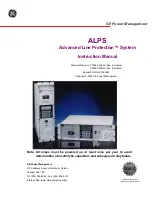
Previously it was verified that the function measures correctly by applying known faults
and observing the graph during monitoring. Besides measuring the fault size a trip
indication is required when a large fault is measured to prevent that a damage to the
generator occurs. To allow the specific function to issue a trip indication, it must first be
enabled:
9.1. Select the Enable Function Tripping button in the ICT toolbar.
9.2. Choose Yes in the pop-up message.
ICT now writes this to IED.
9.3. By default the trip level is set to 1kΩ. In other words, if the fault resistance is lower,
then the function issue trips.
10. Verify the measurements by applying various faults.
Trip indication shall be visible in the ICT toolbar.
11.
Verify that TRIP and ALARM signals are connected to tripping/alarming/signaling/
communication in accordance with the scheme design.
It is very important that the Function Tripping is Enabled under the following
situations:
•
After completion of the calibration step
•
Before leaving the ICT Tool
6.7
Auditing
GUID-70137BAD-6BD5-4835-964E-B6ADAE522A15 v1
During installations, calibrations and commissions the ICT generates reports for each of the
steps and collects them under the Auditing tab. See the procedures below on how to view and
delete reports as well as generate logs from reports.
1.
To view the reports, go to the Auditing tab.
IEC11000049-1-en.vsd
GUID-8348F60B-9BF5-4018-9740-0FA3371B0F9F V1 EN-US
Figure 16: Auditing tab
2.
Open and view each report.
3.
View reports in one of the following ways:
Section 6
1MRK 502 067-UEN B
Calibrating injection based sensitive rotor earth fault protection
60
Commissioning manual
















































